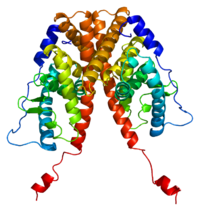
Photo from wikipedia
Angelman syndrome (AS) is a complex genetic disorder that affects the nervous system. AS affects an estimated 1 in 12,000 to 20,000 individuals. Characteristic features of AS includes developmental delay… Click to show full abstract
Angelman syndrome (AS) is a complex genetic disorder that affects the nervous system. AS affects an estimated 1 in 12,000 to 20,000 individuals. Characteristic features of AS includes developmental delay or intellectual disability, severe speech impairment, seizures, small head size (microcephaly), and problems with movement and balance (ataxia). AS individuals usually have microdeletion of the maternal copy of 15q11.2–15q13 region of chromosome 15. The E6-associated protein (E6AP, an E3 ubiquitin protein ligase enzyme) is encoded by the gene UBE3A, which is located in this region, and it has been shown that deregulation of E6AP gives rise to AS and neuropathology of autism spectrum disorders (ASDs) (e.g., autism and Rett syndromes). We have shown that E6AP also acts as a coactivator of the estrogen receptor (ER). ER is a ligand-induced transcription factor that exerts potent and wide-ranging effects on the developing brain. Furthermore, the expression pattern of ER in the brain overlaps with that of E6AP. Up till now, all the published studies have examined the role of the ubiquitin-protein ligase activity of E6AP in the development of AS, and it is not known what role the newly discovered coactivation functions of E6AP and ER plays in the pathology of AS. Here, we demonstrate that E6AP and ER co-immunoprecipitate and are in the same protein complex in neuronal cells (Neuro2a). In addition, both colocalize in nuclear and cytoplasmic compartments of the mouse hippocampal neurons and Neuro2a cells. Moreover, we identified a novel E6AP and ER direct transcriptional regulation of a gene Cyp26b1 known to be involved in learning and memory processes. This transcriptional regulation involves recruitment of E6AP and ER to a newly discovered functional estrogen response element (ERE) located at the Cyp26b1 gene promoter and is associated with transcription permissive epigenetic events leading to increase of active transcription of the gene in neurons upon estrogen treatment. This novel transcriptional regulation was also validated in the AS mouse model where E6AP expression is abrogated in the mouse brain. In fact, Cyp26b1 expression is decreased by 31% in AS mice versus age-matched control (Ctrl) mice hippocampi. Also, retinoic acid transcriptional signaling was shown to be amplified as evidenced by specific increased Rarβ and decreased Erbb4 mRNA expression in AS mice versus Ctrl mice hippocampi. These transcript level changes were also supported by the same trend of changes at the protein level. Collectively, our data present a proof of principle that the transcriptional coactivation function of E6AP may have a crucial role in the pathobiology of AS. This function, yet to be thoroughly investigated, reveals the possibility of harnessing the antagonistic estrogen-retinoic acid transcriptional signaling crosstalk and potentially other unknown effectors for the investigation of important possible targets as putative novel treatment modalities and venues for reversing neurological manifestations in AS and related syndromes like ASDs.
Journal Title: Molecular Neurobiology
Year Published: 2018
Link to full text (if available)
Share on Social Media: Sign Up to like & get
recommendations!